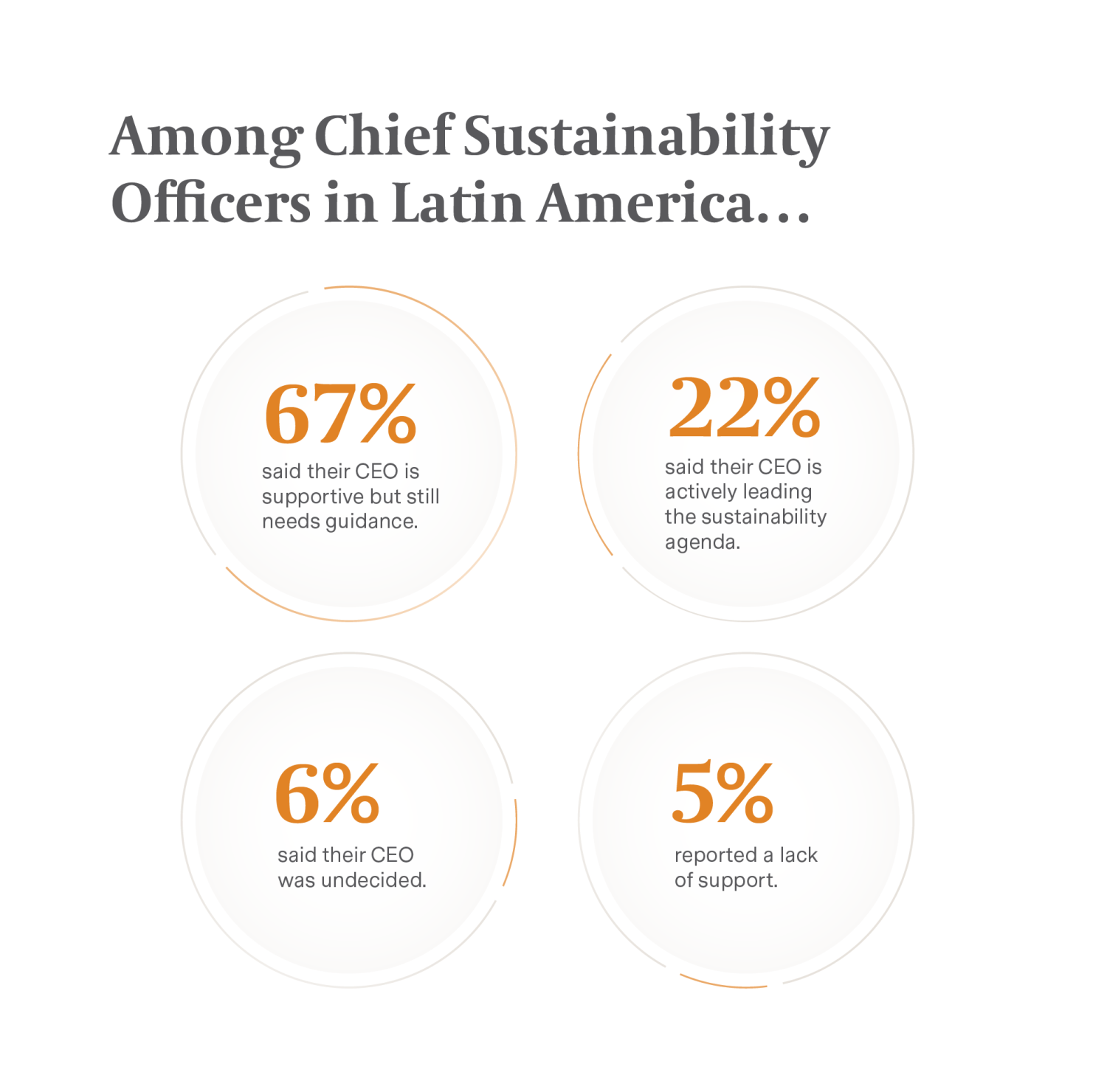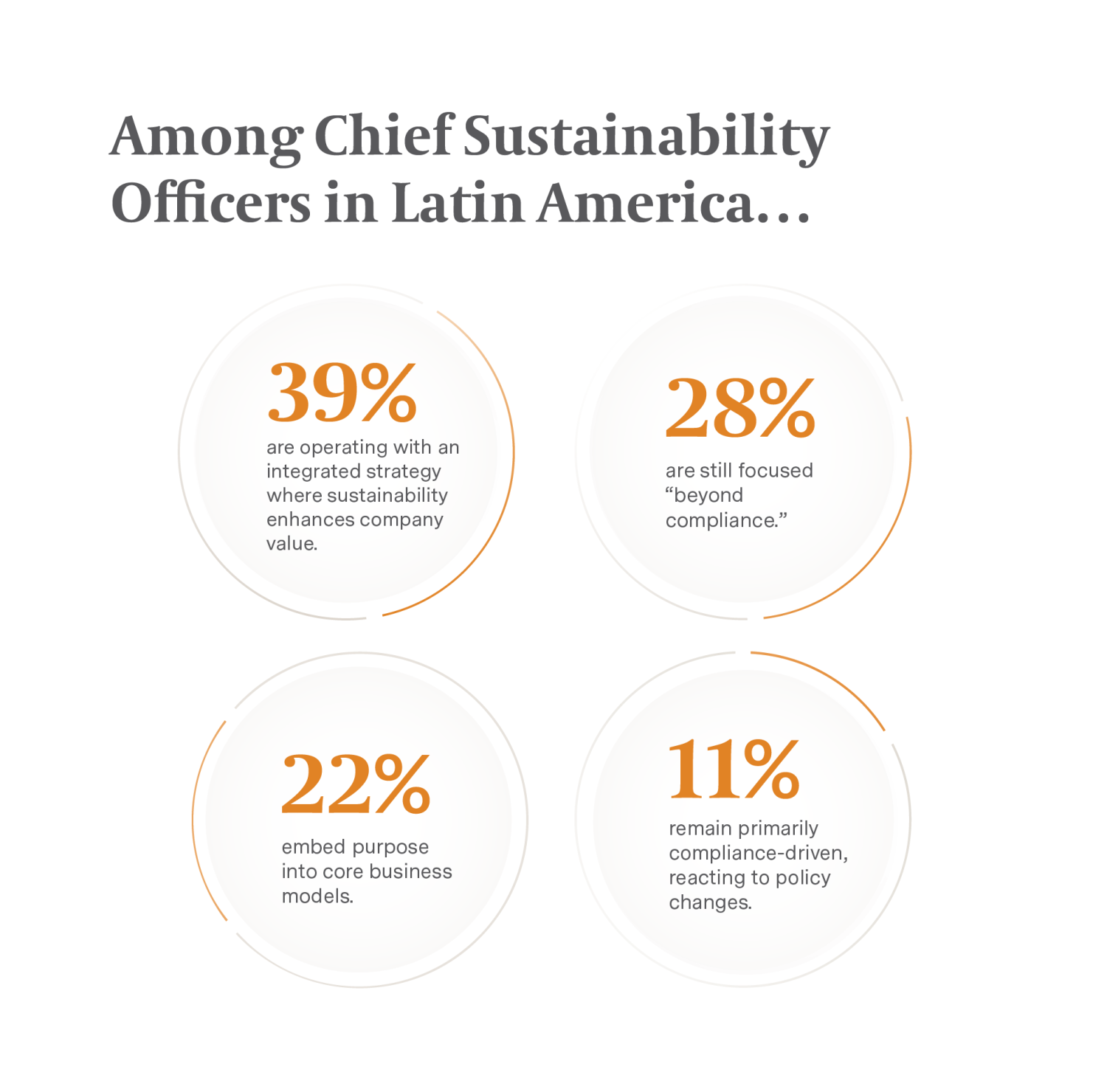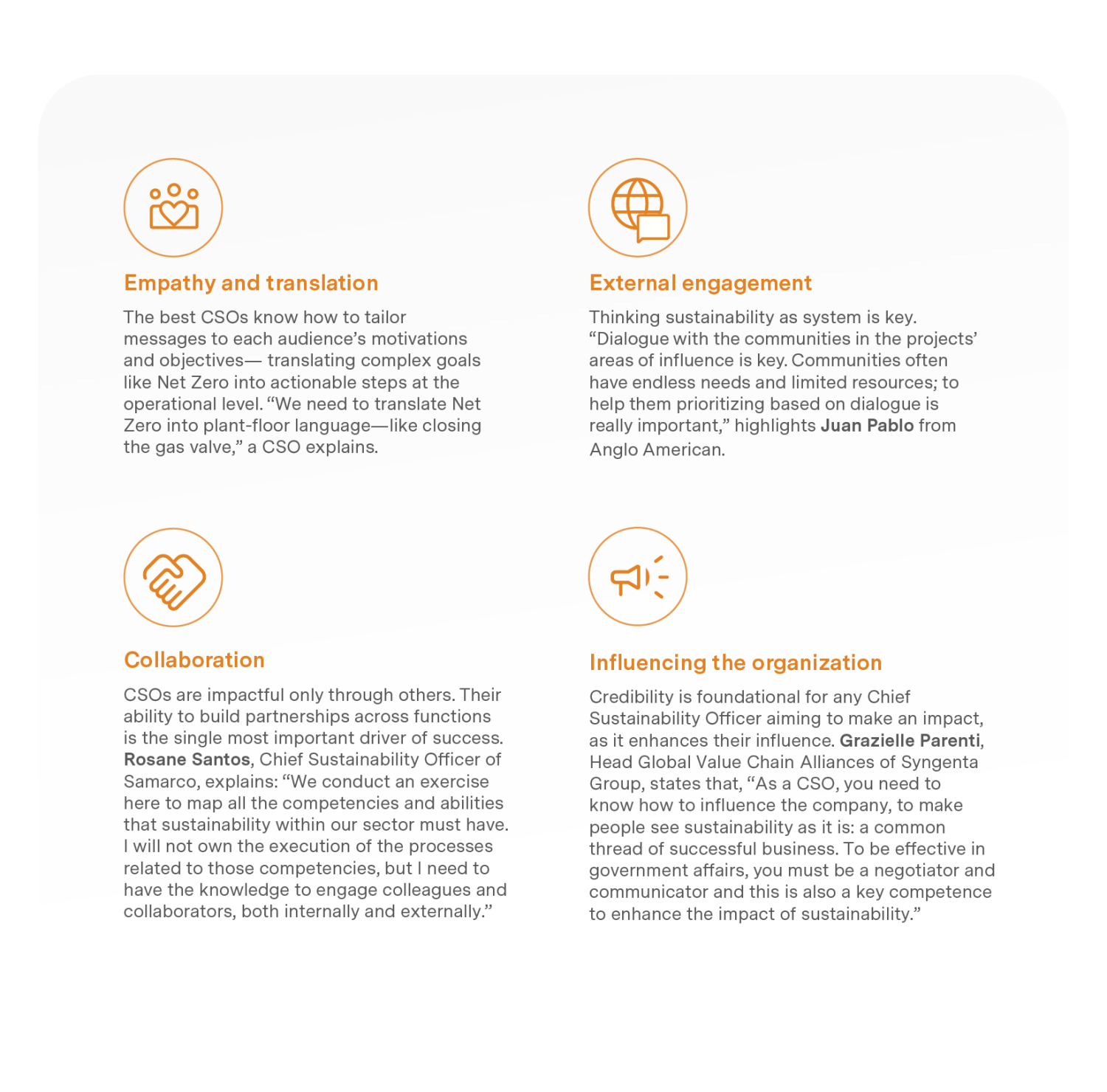Leadership teams are navigating constant disruption. From geopolitical tension to supply chain volatility, to a rapidly evolving regulatory landscape, to uncertainty—ensuring sustainable growth has become deeply complex. Against this backdrop, sustainability can’t be treated as a side initiative. It must be embedded into the core of how organizations design, operate, and grow.
Chief Sustainability Officers are at the center of this transformation. Once focused mainly on ESG reporting, they are now driving business resilience—guiding organizations through complexity, helping leadership navigate transformation, and laying the groundwork for strategies built to endure.
To understand how the role is evolving in Latin America, we spoke with several CSOs from across the region. From strengthening board alignment to redesigning internal structures, we heard that the role is expanding—and fast. We also dd a pulse check of some questions based off our global CSO survey. Read on for the insights.
1. To Lead Transformation, CSOs Need CEO and Board Backing
Nearly all CSOs we talked to emphasized one core truth: transformation cannot be achieved without a united front at the top. They highlighted the critical importance of aligning with CEOs who understand that sustainability isn’t a trade-off with performance—it is performance. Fortunately, that alignment is already taking shape:

(In comparison, our global survey numbers were 42% for CEOs who are supportive but still need guidance; 47% for CEOs actively leading the agenda; 3% for undecided and 3% for those with a lack of support.)
This level of executive engagement signals a growing understanding that sustainability isn’t an add-on, but a leadership imperative. As Juan Pablo Schaeffer, Vice-President of Corporate and Sustainability Affairs of Anglo American, put it: "The leader of the organization must be convinced that sustainability is the right path. Having a leader who supports you and your team is critical to driving change within the organization."
While CEO involvement is a key lever for progress, it must be complemented by strong support from the board and the entire C-Suite. Boards must not only endorse sustainability progress but model and embed it into governance and decision-making. As highlighted by our global study of Chief Sustainability Officers, boards must be more aware of the tension between short- and long-term results and how that impacts the CSO’s work.
“Our CEO wanted that board directors should be involved in sustainability and committees as it is one of the company's core values. We are responsible for material topics; the executives push for progress, while we provide guidance. They understand that sustainability is a precious value for the company", explains Guilherme Abreu, Sustainability General Manager of ArcelorMittal Brasil.
While the urgency of tackling sustainability globally is clear, more immediate issues sometimes overpower key discussions. Alvaro Lorenz, Global Director of Sustainability, Institutional Relations, Product Development and Engineering at Votorantim Cimentos, highlights that short-term results and incentives aren’t always aligned with long-term sustainability, which creates a barrier to advance the agenda: “We’re constantly working to reconcile long-term commitments with short-term pressures. That’s the leadership challenge,” he notes. This is where board directors can purposefully embrace an actively role in shaping a long-term vision, inviting the CSO to present, and establishing a Sustainability Committee.
The partnership is not symbolic—it’s structural. Where CEOs and boards champion sustainability from the top, CSOs are empowered to drive strategic change. Where that support is absent, progress stalls. A Chilean CSO in Financial Services encapsulates this sentiment: “You are part of a system, and in contributing to sustainability progress, we come across two major challenges: Which industries are you going to boost, and how are we going to finance this economy to make it circular? For me, if the Chairman of the Board and the CEO were not committed, we were not going to move forward.”
2. The Role Is Becoming a Hub for Internal Rewiring
When we asked CSOs where their organizations currently sit on the sustainability journey, they said:

This spread highlights both progresses made and yet to be made. The CSO role is evolving not just in scope but in strategic ambition—and many are navigating that evolution in real time. As CSOs become more embedded in the business, they’re increasingly playing a connective role across functions. “We realized that it was key for sustainability to have a change management role and that it should be embedded in the processes. Process specialists need to understand the impact, the business case. Whether by conviction or convenience, but always with a business case,” explains one Chilean CSO.
Think of this as a quiet reengineering of the enterprise: collaborating with CIOs on data infrastructure, CFOs on green capex and ESG reporting, CHROs on culture and capability. "You have to be coherent with what the business wants, what your stakeholders demand, and find the balance. It's about finding the buy-in and identifying who wants to carry that culture," notes Karen Vizental, Chief Sustainability and Global Communications Officer of Arcadium Lithium.
For many companies, this “internal rewiring” is redefining, even if slowly, how their business operates. Vizental exemplifies that. In a previous role she held at a global consumer goods company, she explains, "We changed the mood of the general organization,” she says, adding: “We competed to be the best region vs. the world, highlighting successful cases to transfer to other regions. We promoted cultural change, moving from marketing to brands with purpose. A lot of convincing from the headquarters made there be a lot of conviction."
When asked about their company’s scope of Sustainability, Latin American CSOs reported on the following:
Interestingly, CSOs also highlighted regional nuance in approaching the agenda—we heard some clear differences country to country in how sustainability transformations are implemented—even if the overall goals stay consistent. While the solutions rarely change, CSOs must adapt how they persuade and engage internal stakeholders depending on local contexts, cultures, and business dynamics. The ability to flex influencing styles while staying anchored to strategic priorities is becoming a crucial leadership skill.
3. What Sets Effective CSOs Apart
Key Chief Sustainability Officer Skills
It is no secret that Chief Sustainability Officers are no longer just technical executives. As the role transforms, a heightened need for expanded leadership abilities has become more pronounced in recent years. To succeed, today’s leaders demonstrate a hybrid skillset, with strategic, operational, political skillsets. This diversity in perspectives shone through in how CSOs show up through our conversations, and several skills were mentioned:

The Chief Sustainability Officer Archetypes
Today’s CSOs wear many hats, but most bring a dominant strength or “sustainability spike.” Based on our daily work with CSOs, most leaders reflect a blend of five core archetypes—each essential but rarely mastered all at once. These archetypes are not rigid personas—they’re evolving leadership styles shaped by the company’s stage, strategy, and sector:
- The environmental expert: Focuses on technical depth and climate strategy, drawing from science and environmental systems thinking.
- The champion of people: Leads cultural change, advocating for stakeholder well-being, DEI, and community relationships.
- The policy shaper: Operates at the intersection of compliance, risk, and advocacy—often the CSO most trusted in boardrooms and with regulators.
- The champion of sustainable consumption: Rethinks how and what the company makes, driving shifts in product design, sourcing, and materials.
- The communications expert: Shapes the company’s sustainability narrative internally and externally, ensuring recognition and transparency.

The most effective CSOs are those who can lead across disciplines—partnering with technical experts while speaking the language of investors, boards, and employees alike.
4. CSOs can't move the needle by themselves
Another clear theme: CSOs called for a major shift in how governments and regulators approach sustainability. The current model—rooted in rigid compliance and procedural oversight—is increasingly seen as misaligned with the pace and complexity of today’s sustainability challenges.
- Value-driven reporting, not suffocating compliance: The surge in reporting obligations and shifting compliance metrics is overwhelming many businesses—consuming time, resources, and focus -- without necessarily driving better environmental or social outcomes. Instead of fostering transparency and accountability, the system risks becoming a bureaucratic burden that distracts from real impact.
- Value-driven regulation, not paralyzing permitting: Similarly, heavy-handed regulation that prioritizes perfection over progress risks backfiring. In some cases, overly restrictive permitting processes have caused vital projects to be canceled—undermining both economic and social outcomes.
CSOs warned that dogmatic, intransigent regulatory stances could slow sustainability gains rather than accelerate them. Jorge Lagos, Manager of Corporate and Sustainability Affairs of Grupo CAP, affirms that “Promoting sustainability requires effective regulation that offers certainty. This isn’t about weakening standards, but rather about advancing toward a more flexible and modern regulatory framework—one that reflects today’s projects and the diverse ways they are carried out. Only then can we support initiatives that foster sustainable development, protect the environment, and create value for communities and the nation.”
The message is clear: regulation must evolve from a gatekeeping function to a strategic enabler—one that supports innovation, adapts to context, and helps scale solutions that work.





